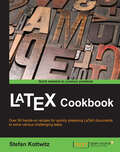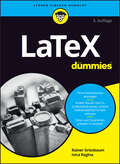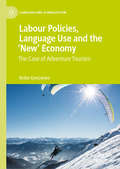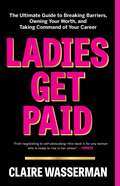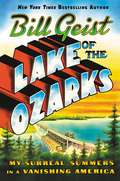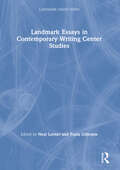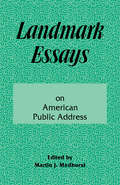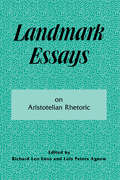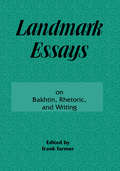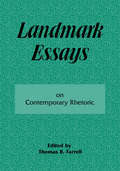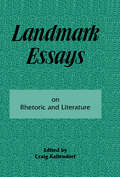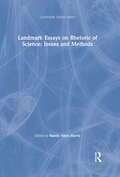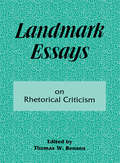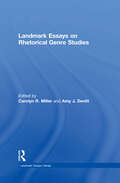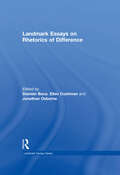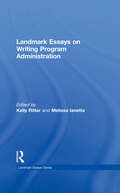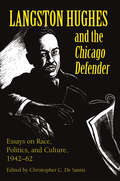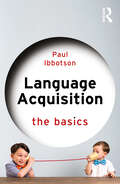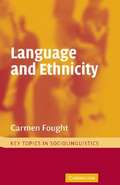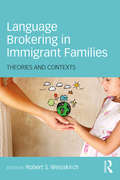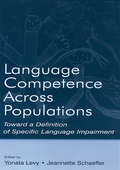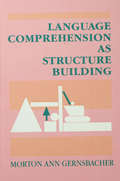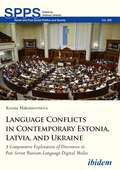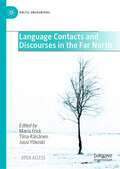- Table View
- List View
LaTeX Cookbook: Over 90 hands-on recipes for quickly preparing LaTex documents to solve various challenging tasks
by Stefan KottwitzA pragmatic guide with actionable recipes on LaTex to apply for tuning text, custom designs, fonts, embedding images, tables, advanced mathematics, and graphics for all your complex documentsKey FeaturesWork with modern document classes, such as KOMA-Script classesExplore the latest LaTeX packages, including TikZ, pgfplots, and biblatexAn example-driven approach to creating stunning graphics directly within LaTeXBook DescriptionLaTeX is a high-quality typesetting software and is very popular, especially among scientists. Its programming language gives you full control over every aspect of your documents, no matter how complex they are. LaTeX's huge amount of customizable templates and supporting packages cover most aspects of writing with embedded typographic expertise.With this book you will learn to leverage the capabilities of the latest document classes and explore the functionalities of the newest packages.The book starts with examples of common document types. It provides you with samples for tuning text design, using fonts, embedding images, and creating legible tables. Common document parts such as the bibliography, glossary, and index are covered, with LaTeX's modern approach.You will learn how to create excellent graphics directly within LaTeX, including diagrams and plots quickly and easily.Finally, you will discover how to use the new engines XeTeX and LuaTeX for advanced programming and calculating with LaTeX.The example-driven approach of this book is sure to increase your productivity.What you will learnChoose the right document class for your project to customize its featuresUtilize fonts globally and locallyFrame, shape, arrange, and annotate imagesAdd a bibliography, a glossary, and an indexCreate colorful graphics including diagrams, flow charts, bar charts, trees, plots in 2d and 3d, time lines, and mindmapsSolve typical tasks for various sciences including math, physics, chemistry, electrotechnics, and computer scienceOptimize PDF output and enrich it with meta data, annotations, popups, animations, and fillin fieldsExplore the outstanding capabilities of the newest engines and formats such as XeLaTeX, LuaLaTeX, and LaTeX3Who this book is forIf you already know the basics of LaTeX and you like to get fast, efficient solutions, this is the perfect book for you. If you are an advanced reader, you can use this book's example-driven format to take your skillset to the next level. Some familiarity with the basic syntax of LaTeX and how to use the editor of your choice for compiling is required.
LaTeX für Dummies (Für Dummies)
by Rainer Griesbaum Ivica RoginaLaTeX lernen leicht gemacht Von der Installation bis zum Druck: Rainer Griesbaum und Ivica Rogina erklären Ihnen in diesem Buch alles, was Sie zu dem bei Mathematikern, Naturwissenschaftlern und Ingenieuren beliebten Textsatzsystem LaTeX wissen müssen. Bringen Sie mit LaTeX umfangreiche Texte elegant in Form und integrieren Sie anschauliche Abbildungen, übersichtliche Tabellen, informative Fu?noten und schön gestaltete mathematische Formeln. Im Handumdrehen haben Sie ein Inhaltsverzeichnis erstellt, ein Register angelegt oder eine ansprechende Präsentation aufgebaut. Das alles können Sie mit dem Online- Editor Overleaf auch im Internet erledigen, alleine oder gemeinsam mit anderen. Sie erfahren Wie Sie LaTeX und eine bersichtliche Arbeitsumgebung einrichten Wie Sie Texte formatieren, Tabellen erstellen oder Formeln setzen Wie Sie Dokumente strukturieren, Verzeichnisse erstellen und Abbildungen einbinden
Labour Policies, Language Use and the ‘New’ Economy: The Case of Adventure Tourism (Language and Globalization)
by Kellie GonçalvesThis book provides an in-depth analysis of language and tourist mobility within an adventure tourism context. It uses a critical and ethnographic approach, contributing to poststructuralist perspectives of social life that are currently undergoing considerable changes on social, political, cultural and linguistic levels. Drawing upon an array of data sources collected over five years on two continents, it examines and compares the way language and communication (e.g. speech, written texts, visual resources) are used within the production of place-making practices in two of the world’s top adventure tourism destinations: Interlaken, Switzerland and Queenstown, New Zealand. It centres on issues such as cross-cultural discourses, transcultural texts, and semiotic landscapes.
Ladies Get Paid: The Ultimate Guide to Breaking Barriers, Owning Your Worth, and Taking Command of Your Career
by Claire WassermanFrom career coach and founder of the startup Ladies Get Paid—the eponymous organization leading the fight for equality in the workplace—comes an empowering guide to provide you with the tools to strategically navigate the workplace, achieve success, and become a true leader. Claire Wasserman has one goal for women: Rise up and get paid. As the founder of Ladies Get Paid, Claire has worked her entire adult life to promote gender equality in the workplace. If you&’re looking to navigate a promotion or break the glass ceiling, Ladies Get Paid is your essential toolkit for achieving success. Filled with straightforward advice and inspiring stories, Ladies Get Paid encourages self-advocacy and activism as a way to advance your career and make more money. Covering topics as crucial and varied as how to find the perfect mentor, how to negotiate a raise, and how to become a leader, Ladies Get Paid is a reminder that you are valuable—both as an individual woman and as part of the female community. And ultimately, it&’s about more than your wallet—it&’s about your worth.
Lake of the Ozarks: My Surreal Summers in a Vanishing America
by Bill GeistBefore there was "tourism" and souvenir ashtrays became "kitsch," the Lake of the Ozarks was a Shangri-La for middle-class Midwestern families on vacation, complete with man-made beaches, Hillbilly Mini Golf, and feathered rubber tomahawks. <P><P> It was there that author Bill Geist spent summers in the Sixties during his school and college years working at Arrowhead Lodge-a small resort owned by his bombastic uncle-in all areas of the operation, from cesspool attendant to bellhop. What may have seemed just a summer job became, upon reflection, a transformative era where a cast of eccentric, small-town characters and experiences shaped (some might suggest "slightly twisted") Bill into the man he is today. <P><P>He realized it was this time in his life that had a direct influence on his sensibilities, his humor, his writing, and ultimately a career searching the world for other such untamed creatures for the Chicago Tribune, the New York Times, and CBS News. <P><P>In LAKE OF THE OZARKS, Emmy Award-winning CBS Sunday Morning Correspondent Bill Geist reflects on his coming of age in the American Heartland and traces his evolution as a man and a writer. He shares laugh-out-loud anecdotes and tongue-in-cheek observations guaranteed to evoke a strong sense of nostalgia for "the good ol' days." <P><P>Written with Geistian wit and warmth, LAKE OF THE OZARKS takes readers back to a bygone era, and demonstrates how you can find inspiration in the most unexpected places. <P><b>A New York Times Bestseller</b>
Landmark Essays in Contemporary Writing Center Studies (Landmark Essays Series)
by Paula Gillespie Neal LernerThis volume collects essential writings in the field of writing center studies as it has blossomed and developed since the 1995 publication of Landmark Essays on Writing Centers. These writings offer a new generation of writing center readers' provocative ideas and research-based praxis on the topics covered in the book’s four parts: Writing Center History, Critical Perspectives on Current Practices, Writing Center Research, and Writing Centers in New Spaces. Its provocative chapters discuss issues including student agency, collaboration, social justice and marginalized populations, community engagement, and online writing instruction. Landmark Essays in Contemporary Writing Center Studies provides an up-to-date introduction to new students and a useful reference for long-time practitioners. It is essential reading for undergraduate and graduate students in composition and education, as well as writing center staff and directors.
Landmark Essays on American Public Address: Volume 1
by Martin J. MedhurstThis volume traces the historical evolution of American academic thought concerning public address -- what it is, how it ought to be studied, and what can be learned by engaging rhetorical texts in an analytical fashion. To begin, one must distinguish among three separate but interrelated uses of the term "public address" -- as practice, theory, and criticism. The essays in this volume represent landmarks in the literal sense of that term -- they are marks on the intellectual landscape that indicate where scholars and ideas have passed, and in that passing left a mark for future generations. It is appropriate to revisit the landmarks that have set public address off as a field of study and it allows readers to remember the struggles that have led to the current situation. Most of the authors of the following chapters are deceased, but their ideas live on -- transformed, adapted, modified, rejected, and reborn. The scholarly dialectic continues. What constitutes a study in public address, how best to approach rhetorical texts, which analytical tools are required for the job, how best to balance text with context and what role ought theory to play in the conduct or outcome of critical inquiry -- these questions live on. To answer them at all is to engender debate and that is how it should be if the intellectual vitality of public address is to be maintained. The papers are a prolegomenon to such studies, for they mark where scholars have been and point the way to where they still must go.
Landmark Essays on Aristotelian Rhetoric: Volume 14
by Richard Leo EnosThere is little doubt that Aristotle's Rhetoric has made a major impact on rhetoric and composition studies. This impact has not only been chronicled throughout the history of rhetoric, but has more recently been contested as contemporary rhetoricians reexamine Aristotelian rhetoric and its potential for facilitating contemporary oral and written expression. This volume contains the full text of Father William Grimaldi's monograph studies in the philosophy of Aristotle's Rhetoric. The eight essays presented here are divided into three rubrics: history and philosophical orientation, theoretical perspectives, and historical impact. This collection provides teachers and students with major works on Aristotelian rhetoric that are difficult to acquire and offers readers an opportunity to become active participants in today's deliberations about the merits of Aristotelian rhetoric for contemporary teaching and research.
Landmark Essays on Bakhtin, Rhetoric, and Writing: Volume 13 (Landmark Essays Ser. #Vol. 13)
by Frank FarmerThe essays in this collection give voice to the plurality of approaches that scholars in the field of rhetoric and composition have when they set forth to assimilate Bakhtin for their varied purposes. The collection is arranged in three major sections. The first attempts to capture the most important theoretical extensions of Bakhtin's ideas, and does so with an emphasis on what Bakhtin might contribute to the present understanding of language and rhetoric. The next section explores the implications of Bakhtin's work for both disciplinary identity and writing pedagogy. The final section looks at how Bakhtinian thought can be used to bring new light to concerns that his work either does not address or could not have imagined addressing concerns ranging from writing across the curriculum to feminism, and from computer discourse to the writing of a corporation annual report. Together, these essays demonstrate how fruitfully and imaginatively Bakhtin's ideas can be appropriated for a context that he could not have anticipated. They also serve as an invitation to sustain the dialogue with Bakhtin in the future, so that researchers may yet come to realize the fortuitous ways that Bakhtin will continue to mean more than he said.
Landmark Essays on Contemporary Rhetoric: Volume 15 (Landmark Essays Ser. #Vol. 15)
by Thomas B. FarrellThis work brings together the pivotal, scholarly essays responsible for the present resurgence in rhetorical studies. Assembled by one of the most respected senior scholars in the field of rhetoric, the essays chart a course from tradition-based theory of civic rhetoric to ongoing issues of figuration, power, and gender. Together with a lucid introductory essay, these studies help to integrate the still-volatile questions at the core of humanities scholarship in rhetoric. The introductory student as well as the seasoned scholar will gain familiarity and footing in this oldest--and still new--liberal art.
Landmark Essays on Rhetoric and Literature: Volume 16 (Landmark Essays Ser. #Vol. 16)
by Craig KallendorfThe studies of rhetoric and literature have been closely connected on the theoretical level ever since antiquity, and many great works of literature were written by men and women who were well versed in rhetoric. It is therefore well worth investigating exactly what these writers knew about rhetoric and how the practice of literary criticism has been enriched through rhetorical knowledge. The essays reprinted here have been arranged chronologically, with two essays selected for each of six major periods: Antiquity, the Middle Ages, the Renaissance (including Shakespeare), the 17th century, the 18th century, and the 19th and 20th centuries. Some are more theoretically oriented, whereas others become exercises in practical criticism. Some cover well-trod ground, whereas others turn to parts of the rhetorical tradition that are often overlooked. Scholars in the field should benefit from having this material collected together and reprinted in one volume, but the essays included here will also be useful to graduate students and advanced undergraduates for course work and general reading. Students of rhetoric seeking to understand how the principles of their field extend into other forms of communication will find this volume of interest, as will students of literature seeking to refine their understanding of the various modes of literary criticism.
Landmark Essays on Rhetoric of Science: Issues and Methods (Landmark Essays Series)
by Randy Allen HarrisLandmark Essays in Rhetoric of Science: Issues and Methods compiles the essential readings of the vibrant field of rhetoric of science, tracing the growth and core concerns of the field since its development in the 1970s.A companion to Randy Allen Harris’s foundational Landmark Essays in Rhetoric of Science: Case Studies, this volume includes essays by such luminaries as Carolyn R. Miller, Jeanne Fahnestock, and Alan G. Gross, along with an early prophetic article by Charles Sanders Pierce. Harris’s detailed introduction puts the field into its social and intellectual context, and frames the important contributions of each essay, which range from reimagining classical concepts like rhetorical figures and topical invention to Modal Materialism and the Neomodern hybridization of Actor Network Theory with Genre Studies. Race, revolution, and Daoism come up along the way, and the empirical recalcitrance of the moon.This collection serves as a textbook for graduate and advanced undergraduate courses in science studies, and is an invaluable resource for researchers concerned with science not as a special, autonomous, sacrosanct enterprise, but as a set of value-saturated, profoundly influential rhetorical practices.
Landmark Essays on Rhetorical Criticism: Volume 5 (Landmark Essays Ser. #Vol. 5)
by Thomas W. BensonThis book is an anthology of landmark essays in rhetorical criticism. In historical usage, a landmark marks a path or a boundary; as a metaphor in social and intellectual history, landmark signifies some act or event that marks a significant achievement or turning point in the progress or decline of human effort. In the history of an academic discipline, the historically established senses of landmark are mixed together, jostling to set out and protect the turfmarkers of academic specialization; aligning footnotes to signify the beacons that have guided thought and, against these "conservative" tendencies, attempting to contribute fresh insights that tempt others along new trails. The editor has chosen essays for this collection that give some sense of the history of rhetorical criticism in this century, especially as it has been practiced in the discipline of speech communication. He also emphasizes materials that may illustrate where the discipline conceives itself to be going -- how it has marked its boundaries; how it has established beacons to invite safety or warn us from the rocks; and how it has sought to preserve a tradition by subjecting it to constant revision and struggle. In the hope of providing some coherence, the scope of this collection is limited to rhetorical criticism as it has been practiced and understood within the discipline of speech communication in North America in this century.
Landmark Essays on Rhetorical Genre Studies (Landmark Essays Series)
by Carolyn R. Miller Amy J. DevittLandmark Essays on Rhetorical Genre Studies gathers major works that have contributed to the recent rhetorical reconceptualization of genre. A lively and complex field developed over the past 30 years, Rhetorical Genre Studies is central to many current research and teaching agendas. This collection, which is organized both thematically and chronologically, explores genre research across a range of disciplinary interests but with a specific focus on rhetoric and composition. With introductions by the co-editors to frame and extend each section, this volume helps readers understand and contextualize both the foundations of the field and the central themes and insights that have emerged. It will be of particular interest to students and scholars working on topics related to composition, rhetoric, professional and technical writing, and applied linguistics.
Landmark Essays on Rhetorics of Difference (Landmark Essays Series)
by Ellen Cushman Damián Baca Jonathan OsborneLandmark Essays on Rhetorics of Difference challenges the Eurocentric perspective from which the field of rhetoric is traditionally viewed. Taking a step beyond the creation of alternative rhetorics that maintain the centrality of the European and Greco-Roman tradition, this volume argues on behalf of pluriversal rhetorics that coexist as equally important on their own terms. A timely addition to the respected Landmark Essays series, it will be invaluable to students of history of rhetoric, literacy, composition, and writing studies.
Landmark Essays on Writing Across the Curriculum: Volume 6 (Landmark Essays Ser. #Vol. 6)
by Charles Bazerman; David RussellRhetoric, as a general teaching -- while preaching locality of action and guidelines for handling that locality -- has tended from the beginning to serve as a universality. It has offered a generalized techne with only limited categories, appropriate for all discursive situations, at least for those that were not excluded from the realm of rhetoric. Nonetheless, from its beginnings, rhetoric limited its interests to certain activity fields such as law, government, religion, and most important, the educators of leaders in these activity fields. This collection presents landmarks showing where the Writing-Across-the-Curriculum (WAC) and Writing in the Disciplines (WID) movements have gone. They have opened up a number of prospects that were impossible to see when rhetoric and composition confined their gaze to relatively few discursive activities. This suggests that the rhetorical landscape is becoming more complex and interesting, as well as more responsive to life in the complex, differentiated societies that have emerged in the last few centuries. This volume will reveal to scholars and researchers a range of possibilities for the study of disciplinary discourse and its teaching, and suggest to them new prospects for the future -- and for the better.
Landmark Essays on Writing Program Administration (Landmark Essays Series)
by Kelly Ritter Melissa IanettaLeading with the provocative observation that writing programs administration lacks “an established set of texts that provides a baseline of shared knowledge... in which to root our ongoing conversations and with which to welcome newcomers,” Landmark Essays on Writing Program Administration focuses on WPA identity to propose one such grouping of texts. This Landmark volume is the cornerstone resource for new Writing Program Administrators and graduate students seeking an ever-important overview of the literature on Writing Program Administration. Drawing broadly across scholarship in writing programs and writing centers, Ritter and Ianetta work to historicize, theorize, and problematize the ever-shifting answers offered to the question: Who—or what—is a WPA?
Langston Hughes and the *Chicago Defender*: Essays on Race, Politics, and Culture, 1942-62
by Langston HughesLangston Hughes is well known as a poet, playwright, novelist, social activist, communist sympathizer, and brilliant member of the Harlem Renaissance. He has been referred to as the "Dean of Black Letters" and the "poet low-rate of Harlem." But it was as a columnist for the famous African-American newspaper the Chicago Defender that Hughes chronicled the hopes and despair of his people. For twenty years, he wrote forcefully about international race relations, Jim Crow, the South, white supremacy, imperialism and fascism, segregation in the armed forces, the Soviet Union and communism, and African-American art and culture. None of the racial hypocrisies of American life escaped his searing, ironic prose. This is the first collection of Hughes's nonfiction journalistic writings. For readers new to Hughes, it is an excellent introduction; for those familiar with him, it gives new insights into his poems and fiction.
Language Acquisition: The Basics (The Basics)
by Paul IbbotsonLanguage Acquisition: The Basics is an accessible introduction to the must-know issues in child language development. Covering key topics drawn from contemporary psychology, linguistics and neuroscience, readers are introduced to fundamental concepts, methods, controversies, and discoveries. It follows the remarkable journey children take; from becoming sensitive to language before birth, to the time they string their first words together; from when they use language playfully, to when they tell stories, hold conversations, and share complex ideas. Using examples from 73 different languages, Ibbotson sets this development in a diverse cross-cultural context, as well as describing the universal psychological foundations that allow language to happen. This book, which includes further reading suggestions in each chapter and a glossary of key terms, is the perfect easy-to-understand introductory text for students, teachers, clinicians or anyone with an interest in language development. Drawing together the latest research on typical, atypical and multilingual development, it is the concise beginner's guide to the field.
Language And Ethnicity: Key Topics in Sociolinguistics
by Carmen FoughtWhat is ethnicity? Is there a 'white' way of speaking? Why do people sometimes borrow features of another ethnic group's language? Why do we sometimes hear an accent that isn't there? This lively overview, first published in 2006, reveals the fascinating relationship between language and ethnic identity, exploring the crucial role it plays in both revealing a speaker's ethnicity and helping to construct it. Drawing on research from a range of ethnic groups around the world, it shows how language contributes to the social and psychological processes involved in the formation of ethnic identity, exploring both the linguistic features of ethnic language varieties and also the ways in which language is used by different ethnic groups. Complete with discussion questions and a glossary, Language and Ethnicity will be welcomed by students and researchers in sociolinguistics, as well as anybody interested in ethnic issues, language and education, inter-ethnic communication, and the relationship between language and identity.
Language Brokering in Immigrant Families: Theories and Contexts
by Robert S. WeisskirchLanguage Brokering in Immigrant Families: Theories and Contexts brings together an international group of researchers to share their findings on language brokering—when immigrant children translate for their parents and other adults. Given the large amount of immigration occurring worldwide, it is important to understand how language brokering may support children’s and families’ acculturation to new countries. The chapter authors include overviews of the existing literature, insights from multiple disciplines, the potential benefits and drawbacks to language brokering, and the contexts that may influence children, adolescents, and emerging adults who language broker. With the latest findings, the authors theorize on how language brokering may function and the outcomes for those who do so.
Language Competence Across Populations: Toward a Definition of Specific Language Impairment
by Yonata Levy Jeannette SchaefferThis unique, edited book bridges studies in language disorders and linguistic theory with timely contributions from leading scholars in language development. It presents an attempt to define Specific Language Impairment, relating it to children of normal and disordered language capabilities. The chapter presentations examine language development across a variety of populations of children, from those with Specific Language Impairment to second language learners. The contributors discuss criteria for the definition of SLI, compare and contrast SLI with profiles of children with other disorders and dialects, and offer a comprehensive look at the Whole Human Language, which ties together spoken and signed languages. Methodological concerns that affect the credibility and generalizability of the findings are discussed and controversies between opposing linguistic approaches to language acquisition are presented. The conceptual thread that gradually reveals itself as the chapters unfold is a theoretical issue of central importance to cognitive theory, as well as to our understanding of the biological correlates of language--it concerns the variability that linguistic competence can manifest in children under different biological conditions and life circumstances. Language Competence Across Populations: Toward a Definition of Specific Language Impairment is an essential volume for advanced students and scholars in linguistics and psychology who have an interest in language acquisition and language disorders, as well as for the clinical professionals dealing with children with language impairments.
Language Comprehension As Structure Building
by Morton Ann GernsbacherThis book presents a new theoretical framework -- what Gernsbacher calls the Structure Building Framework -- for understanding language comprehension in particular, and cognitive processing in general. According to this framework, the goal in comprehending both linguistic and nonlinguistic materials is to build a coherent mental representation or "structure" of the information being comprehended. As such, the underlying processes and mechanisms of structure building are viewed as general, cognitive processes and mechanisms. The strength of the volume lies in its empirical detail: a thorough literature review and solid original data.
Language Conflicts in Contemporary Estonia, Latvia, and Ukraine: A Comparative Exploration of Discourses in Post-Soviet Russian-Language Digital Media (Soviet and Post-Soviet Politics and Society #205)
by Ksenia MaksimovtsovaLanguage policy and usage in the postcommunist region have continually attracted wide political, media, and expert attention since the disintegration of the USSR in 1991. How are these issues politicized in contemporary Estonia, Latvia, and Ukraine? This study presents a cross-cultural qualitative and quantitative analysis of publications in leading Russian-language blogs and news websites of these three post-Soviet states during the period of 2004–2017.The most notable difference observed between Ukraine and the two Baltic countries is that many Russian-writing users in Ukraine’s internet tend to support the position that the state language, i.e. Ukrainian, is discriminated against and needs special protection by the state, whereas the majority of the Russian-speaking commentators on selected Estonian and Latvian news websites advocate for introducing Russian as a second state language. Despite attempts of Ukraine’s government to Ukrainize public space, the position of Ukrainian is still perceived, even by many Russian-writing commentators and bloggers, as being ‘precarious’ and ‘vulnerable.’ This became especially visible in debates after the Revolution of Dignity, when the number of supporters of the introduction of Russian as second state language significantly decreased. In the Russian-language sector of Estonian and Latvian news websites and blogs, in contrast, the majority of online users continually reproduce the image of ‘victims’ of nation-building. They often claim that their political, as well as economic rights, are significantly limited in comparison to ethnic Estonians and Latvians.The results of Maksimovtsova’s research illustrate that, notwithstanding differences between the Estonian as well as Latvian cases, on the one hand, and Ukraine, on the other, there is an ongoing process of convergence of debates in Ukraine to those held in the other two countries analyzed in terms of an increased degree of ‘discursive decommunization’ and ‘derussification.’
Language Contacts and Discourses in the Far North (Arctic Encounters)
by Tiina Räisänen Maria Frick Jussi YlikoskiThis open access book sheds light on 21st-Century multilingualism in the Far North of Europe – Finland, Sweden, Norway, and Estonia – an area with multifaceted contacts between many Uralic and Indo-European languages. These contacts are taking new forms as migration and English as the lingua franca are changing the linguistic situation remarkably. The national languages dominate the life of most inhabitants, while the use of indigenous Saami languages, old minority languages, and the languages of new immigrants is limited to certain areas or domains. This volume takes a close look at multilingual individuals and discusses how their lives are affected by different languages.
